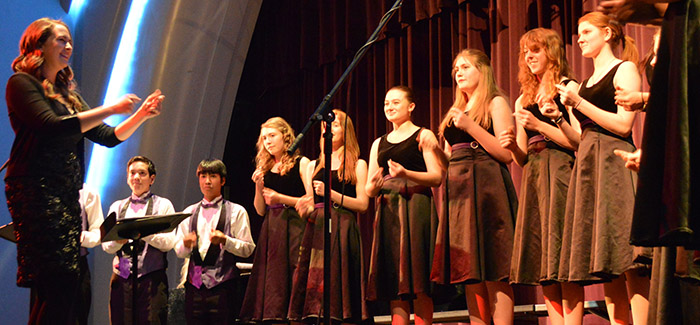
In my experience, many young singers suffer from a misconception that they simply cannot read music. While it may be true that their current skills do not match those of their instrumentalist counterparts, I am baffled by how often I hear my newer singers say, “Oh, I can’t read this,” or “I don’t know how to read music, I just know how to sing.”
I want to address three factors that contribute to a singer’s negative perception of their music reading skills. I believe that we as teachers need to address them from multiple pedagogical angles to help solve this crisis of confidence and create braver, better readers.
1. The Sheer Terror of Singing a Wrong Note
Singing in front of other people is scary. I think it stems from the popular fallacy that you’re either a Good Singer or a Bad Singer. No one expects to play the trumpet for the first time with perfect intonation and breath support, reading music notes correctly and with fluency. They have to learn how the instrument works and practice. The same line of thinking is not generally applied to the voice.
Somehow, because we are born with a musical instrument pre-installed, we are expected to be able to use our voices beautifully, with no training, or else to not use them at all. In this way, our students are encouraged to embrace their ignorance and lack of skill. For them, it’s safer not to know than it is to risk looking silly by trying to learn. They’d much rather parrot a popular song on the radio than experiment with their own unique sound. In the phrase “I don’t know”, they find an excuse instead of a challenge. But “I don’t know” is not an acceptable excuse in any area of discipline or study. Music is not an exception.
Singing is just like any other skill or craft, in that effective, guided practice, discipline and hard work will result in improvement. As simple as this idea is, your students need to hear you say it – and come to trust that you believe it by seeing you live it out.
Dismantling the myth of Good and Bad Singing is the key to giving your singers the courage to make mistakes. It begins with creating a culture of curiosity and mutual support. In a curious classroom, solo and small-group singing is common, and met with immediate positive reinforcement and specific feedback. Mistakes are addressed with authenticity and technical language instead of value judgments. Provide this model consistently; your ensemble will follow suit. Students take ownership of their improvement when they have the confidence and skills to self-evaluate without fear of judgment.
I have a lot of success with my singers when we approach the voice as an instrument. I want them to understand that, like trumpet players, they need to become familiar with their instruments before they can use them efficiently and beautifully.
2. The Gap Between Music Theory and Ear Training
The key to trained ears and good relative pitch is gradually developing the skill of audiation, which is the skill of recognizing and “pre-hearing” notes before they are produced. My singers work on this every day, for a few minutes at a time. We use a program called 4-Minute Mastery, developed for and piloted by our school district, which introduces Music Theory concepts through sight singing examples. When Theory concepts and Ear-Training are introduced side-by-side in a lesson, the skill of audiation is strengthened; the singer understands the concept intellectually and is able to reproduce it musically.
3. Inconsistent Levels of Difficulty Between Sight-Reading and Repertoire
Our music classrooms are filled with students at various levels of music literacy. It is our job to program educationally rich, interesting repertoire for students at every level. While it’s not necessary to choose music based on the lowest reading level in the class, it’s important to provide repertoire that will allow students to experience some success at their current level of reading.
We also need to plan differentiated rehearsals around identifying familiar concepts or symbols in the music, while using literacy skills and other resources to “decode” unfamiliar notation. While it may be tempting to program something flashier and muscle your way through it, you will force your singers to rely on their ears instead of their reading skills to make progress, undermining the self-efficacy you’ve worked to instill.
Creating an authentically supportive and curious classroom culture, reinforcing audiation skills and reading strategies, and providing level-appropriate repertoire will all increase confidence and musicianship in the Choral classroom. Our singers need and deserve to feel accomplished and confident while they continue to improve and become self-sufficient, curious, life-long musicians.
 Emily Williams is in her fourth year of teaching choral music. After receiving her degree from the University of Colorado at Boulder and teaching in Colorado for three years, she relocated to the Pacific Northwest and is currently teaching middle and high school choir in the Northshore School District.
Emily Williams is in her fourth year of teaching choral music. After receiving her degree from the University of Colorado at Boulder and teaching in Colorado for three years, she relocated to the Pacific Northwest and is currently teaching middle and high school choir in the Northshore School District.